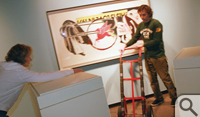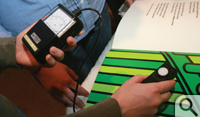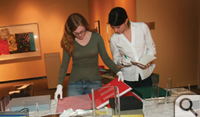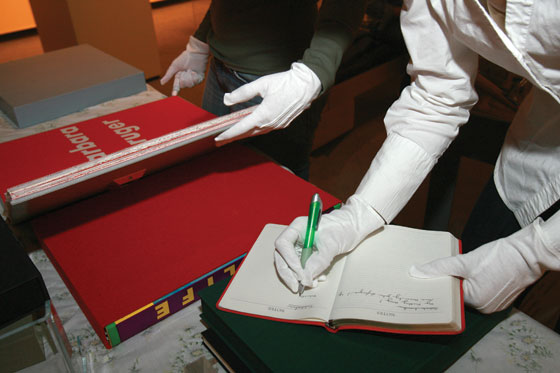The Museum is a Lab
The Muscarelle is more than a bunch of pretty faces
So how do you put your best face forward when the audience is constantly changing? And who is the audience on any given day?
The Muscarelle Museum at William and Mary just celebrated its 25th birthday amid much splendor, including its recent coup, an exhibition from Italy's famed Uffizi Gallery. But just as impressive is that side which might be invisible to some audiences: the teaching, the research and the partnering between museum and classroom.
 “The museum really has two faces,” says Muscarelle Director Aaron De Groft ’88. “One which is very public, the town-and-gown face. But there is also the face that looks in, toward the campus, to serve the students and the faculty.”
“The museum really has two faces,” says Muscarelle Director Aaron De Groft ’88. “One which is very public, the town-and-gown face. But there is also the face that looks in, toward the campus, to serve the students and the faculty.”
By all accounts, the museum is looking both ways, offering a wide array of experiences—artistic, cultural and academic—to internal as well as external users. For example, William and Mary students participate in the conservation, acquisition, cataloging and writing that goes on behind the scenes in this special place. There are students conducting research; there are docents, interns and volunteers. There are MUSE (Museum University Student Exchange) students working closely with staff to publicize events.
It’s this face of the Muscarelle, the one that turns toward campus, that De Groft says brought him back to Virginia from a position at a top-tier art museum in Florida. In his two years since taking the helm, De Groft has guided the museum into uncharted waters as an academic partner on campus, creating a laboratory of sorts for faculty and students.
“The Muscarelle is a vehicle for teaching and research,” says De Groft, “that goes to the core of William and Mary’s academic mission.”
“This is a place,” De Groft said, “that goes to the very heart of what a museum originally was conceived of in Greece—a place where people come together for discussion and learning.”
Not just for arts majors
 Working in the Muscarelle is not just for the arts majors. Some of the students who work at the museum help with exhibitions and lighting; others help with painting. A group of business school students recently managed an entire traveling exhibition, marketing materials from design and concept to implementation and production, even creating a flash DVD.
Working in the Muscarelle is not just for the arts majors. Some of the students who work at the museum help with exhibitions and lighting; others help with painting. A group of business school students recently managed an entire traveling exhibition, marketing materials from design and concept to implementation and production, even creating a flash DVD.
“We also have a lot of independent study students,” says De Groft. “They are serving internships for credit—real-world projects—that they can use on their résumés. This kind of experience gets them into graduate school or into the workplace.”
Art students study techniques and conduct research, taking advantage of some 3,000 drawings and prints in the Herman Prints and Drawing Room. A photography class visits to see over 275 original photographs from some of the greatest American artists.
“They come to look at the great photographs,” De Groft says, “because there is something value-added about seeing how they’re printed, the color and surface of the paper—all of these dealing with the real object—that is the lab component that reinforces the classroom which is the same model for a lot of other things around campus.”
Beyond art and photography, other classroom clients include visitors from Japanese film studies, art and art history and Russian studies. A geology class even walked over from McGlothlin-Street Hall to study geological formations in Clyde Butcher’s landscape photography. There have been Spanish students writing papers on works of art (in Spanish, of course), and visits by Charles Center students and Sharpe Scholars.
“I really do think,” says Carl Strikwerda, dean of the faculty of arts and sciences, “that one of the things Aaron has done so skillfully is that he has sized up the resources the College faculty has, and has brought them into the museum while taking the resources of the museum and making them available to what is being taught in classrooms across campus. There is real integration going on.”
Bring in the deans
 De Groft forges his link between museum to the classroom, starting with a committee whose core includes Strikwerda, Dean of the University Libraries Connie Kearns McCarthy and Dean of the School of Education Virginia McLaughlin. Sometimes he brings in folks from Special Collections at Swem Library or department chairs or still others depending upon the projects he has in mind. Everyone brainstorms and themes emerge.
De Groft forges his link between museum to the classroom, starting with a committee whose core includes Strikwerda, Dean of the University Libraries Connie Kearns McCarthy and Dean of the School of Education Virginia McLaughlin. Sometimes he brings in folks from Special Collections at Swem Library or department chairs or still others depending upon the projects he has in mind. Everyone brainstorms and themes emerge.
“It helps to have an excellent library and enthusiastic colleagues,” De Groft says. “Connie McCarthy has been a great collaborator, with [library staffers] Bea Hardy and Amy Schindler, in brainstorming and opening up their collections. There is fascinating stuff, but it just can’t be in the private playground of the people who get to deal with it.”
In 2007, as all eyes were on Jamestown’s 400th anniversary, the museum partnered with the anthropology department’s American Indian Resource Center to co-curate an exhibition which effectively kicked off the Muscarelle’s Year of American Art. The exhibition was titled Jaune Quick-To-See Smith: Contemporary Native American Paintings and the Response to Colonization...Anniversary of the Beginning…Beginning of the End.
“We addressed provocative and difficult issues of a Native American artist’s response to colonization, as well as exhibiting very important early documents and special collections of the College that represent the beginnings of the Americans and the Native Americans,” De Groft said.
The museum is housed in a brick building that is small by standards of great museums, but don’t let size fool you. This is the museum that just showcased Painting the Italian Landscape: Views from the Uffizi, covering five centuries of landscape painting and featuring more than 40 works from renowned artists like Botticelli, Nicolas Poussin and Canaletto.
Even when the Old Masters aren’t in town, the Muscarelle holds plenty of names. The rotating permanent collection boasts more than 3,000 works of art, a number that might be considered small by some standards.
Small, but mighty
“But step inside the front door,” invites Becky Shields, curatorial fellow at the Muscarelle, “and you’re greeted by an original O’Keefe. Five feet to the left, a Titian. Just a few steps to the right, a Velazquez. By any standard, it’s a good day at the museum.”
Portraits are central to the permanent collection, beginning with the very first piece—a portrait of physicist Robert Boyle given to the College in 1732 by the third Earl of Burlington. There are 200 years of English and American portraits of the 17th, 18th and 19th centuries but also an extensive collection of American and European art and landscapes. Within the permanent collection, there is African art, Asian prints and ceramics and American abstract expressionist paintings.
De Groft and the Muscarelle are always open to ideas. Last year a group of students approached De Groft about displaying a traveling exhibition called PostSecret. The exhibition was fairly shocking, De Groft said, and consisted of thousands upon thousands of postcards sent to an address from a web site. In their postcards, people share their deepest secrets—tragic, terrible, therapeutic, scandalous, loving, happy or sad.
“These are cultural artifacts—art of their time—so we hung the exhibit in the middle of the permanent collection,” says De Groft.
 De Groft also oversees the President’s Collection of Faculty and Student Art and enjoys working with Bob Knowlton of the University Center, to display pieces in the UC from that collection as well as other student-arranged exhibitions. The University Center offers space which is accessible and dramatic, and provides a fitting backdrop for pieces that do not require museum-quality lighting and security.
De Groft also oversees the President’s Collection of Faculty and Student Art and enjoys working with Bob Knowlton of the University Center, to display pieces in the UC from that collection as well as other student-arranged exhibitions. The University Center offers space which is accessible and dramatic, and provides a fitting backdrop for pieces that do not require museum-quality lighting and security.
In collaboration with the Student Health Center, the AIDS quilt hung in the museum for a week. In addition, the museum participated in a University Center exhibition of a collection called The Art of Surviving, undertaken with the College’s sexual abuse counselors, and arranged an international volunteerism display when Governor Tim Kaine was on campus in January.
“And for our fourth exhibit at the UC,” says De Groft, “we are helping the International Studies Club with photographs which they will produce— which we will mount and hang—reflecting what their group has done in terms of volunteer efforts." 
















